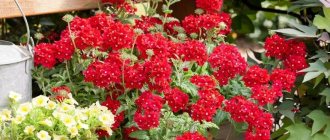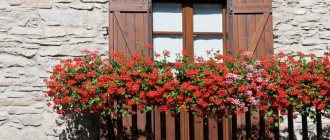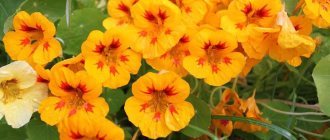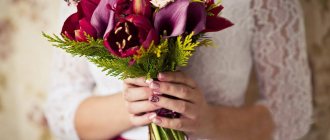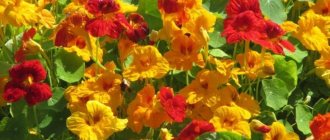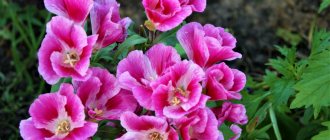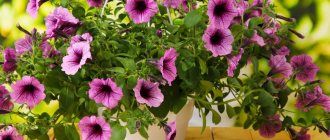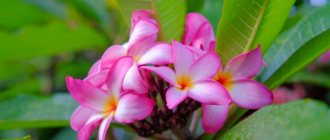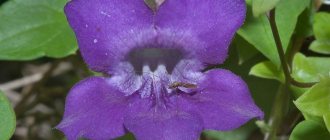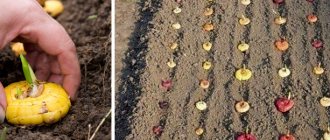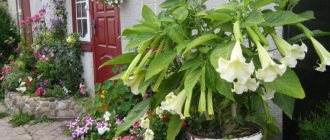WonderWoman
8475 0 0
WonderWoman September 16, 2016You can talk at length about canons in design, but every day the existing canons are becoming less and less stable. Aesthetics and harmony, balance, colors, materials brought together in order to obtain such a long-awaited result are the essence of your knowledge, practice and self-development. My motto is to learn, see, touch something new every day, and I am sure that this is the only way to stay on the right course in “high design.”
Nasturtium is a plant that was brought to us from Central America. Today the culture has become so popular that it is actively used in park design, decorating balconies and loggias, and simply as a green favorite “warming up” on the windowsill. So, nasturtium on the balcony: choice of variety, rules of cultivation and care - the topic of my small botanical opus.
Multi-colored gramophone flowers, when properly cared for, line an entire carpet
The nasturtium genus has about 40 species that belong to the categories of annual and perennial herbaceous or semi-shrub plants. The stems are fleshy and juicy, branched, erect, climbing or creeping, reaching up to 2.5 m in length.
Nasturtium is easily recognized by its round, shield-shaped leaves with a solid edge, bright green in color with a slight waxy coating. The flowers are velvety single, located on long peduncles.
They have a pleasant, light aroma. The color palette includes shades of red, orange, yellow. The period of active flowering is from mid-spring until the first frost.
Variety "Orange Ray"
The breeding of new varieties does not stop for a second: today nasturtium is represented not only by giant shrubs with tentacled lashes, but also by compact species with a height of only 15 cm. The leaves of the plant have also undergone changes; classic green, reddish and variegated colors are available.
I recommend using climbing varieties for vertical gardening; creeping varieties look great in boxes; companions are often selected for dwarf varieties.
In the photo is the “Empress of India” variety, which will certainly appeal to lovers of scarlet color
Decorating balconies
The flower is distinguished by a huge variety of varieties, sizes and shapes, so choosing the most suitable decor for your loggia is quite easy. There are both low-growing and tall, and creeping varieties that can be placed in pots of various sizes, placed on a support, creating a curtain around the balcony, or hung outside in special boxes. The variety of warm shades allows you, if desired, to create a flower arrangement only from nasturtiums.
Rules for planting and care
Growing nasturtium on a balcony requires compliance with a number of conditions. Despite the fact that the plant is considered not too demanding, you need to remember that:
- Nasturtium is light-loving ; it cannot be planted on northern, gray-western and north-eastern balconies. The ideal place for it is if the balcony faces south, southeast or southwest;
- The soil in the pot should not be too dense ; a universal soil will do;
- It is necessary to water as the soil dries , avoiding either waterlogging or drying out of the soil;
- Replanting is a great stress for the flower and a high risk of damage to the root system; it should be done as rarely as possible;
- Nasturtium does not tolerate frost well ; it needs to be put in a warm room for the winter.
There are also plants that are more demanding of different conditions, so nasturtium is considered the least capricious of them.
Caring for container nasturtiums
The flower can be grown in open ground at a summer cottage or in a front garden, but other types of this plant - the so-called container varieties - will take root on the balcony.
Neighbours
Nasturtium can be combined with other plants - varieties of geranium, sage, petunia and rosemary. Bluish, blue and purple flowers perfectly highlight the warm shades of nasturtium.
If a climbing form of flower grows on the balcony, you can combine it with blue or blue morning glory or garden chamomile. All these plants have similar environmental requirements , but with sufficient watering and fertilizing they do not compete with each other.
Lighting and temperature
The flower is extremely light-loving - it needs to be planted on the sunny side, if this is not possible, arrange additional lighting. The plant is demanding in terms of temperature - you need to plant nasturtium on the balcony when the frosts have completely passed.
The soil
Nasturtium is not picky about soil. The only thing worth considering is that it should be quite loose. Dense soils - loams, salt marshes and others - cannot be used or must be mixed with sand. It is best to buy a universal primer for flowers.
Watering
The nasturtium on the balcony (photo can be seen online) is watered daily as the soil dries out. If the soil has good hygroscopicity and retains moisture for a long time, you can reduce the number of waterings. The plant should be sprayed in the evening after sunset.
Top dressing
You should buy fertilizers with a high nitrogen content. They need to be given to plants every week until flowering. After the flowers appear, you need to feed the plant half as often. Excess feeding can reduce the number of flowers during rapid growth of greenery.
Features of care
To make the plant look beautiful, it is necessary to remove excess shoots and give it the desired shape. During flowering, it is better to remove faded buds from the nasturtium - then the flowers will appear more abundantly.
Mr. Summer Resident recommends: ways to plant nasturtium seeds for seedlings
In addition to the traditional method of planting seeds for seedlings, there are others that are economical and convenient. Soaking and germinating nasturtium in sawdust speeds up the germination process.
Planting in sawdust
Sawdust from deciduous trees is used as a planting mixture. Conifers have a high resin content.
They are well dried and ventilated. Then moisten with water. For home growing seedlings, it is convenient to use granulated pressed sawdust poured into the cat litter. They retain moisture well and have undergone a cleaning procedure.
The granules are poured with boiling water and allowed to swell. You should not pour too much water; the planting mixture should be loose. It is poured into a container no more than 3.5 cm thick. There should be sides of at least 5 cm. This is enough for nasturtium seeds. They are not pre-soaked, they are laid out dry on sawdust at a distance of 4 to 6 cm. Covered with a centimeter layer. After this, the container is tightly covered with film and put in a warm place for 4-5 days - tropical conditions are created. The seeds do not need sunlight; they germinate well in a dark place. The main factors: high humidity and temperature. Under such sowing conditions, sprouts appear on average within five days. The film is removed, the seedlings are moistened and transferred to a bright place. After the appearance of the third full leaf, they are transferred to pots with soil without damaging the roots. The young plant quickly adapts to new conditions. In loose sawdust, the roots are not damaged, and the seedlings are easily removed.
Landing in the "snail"
To germinate large seeds, thick plastic film and toilet paper are often used. You will need a strip 10 cm wide; the length of the planting “snail” depends on the number of seeds. You need to lay a strip of 3-ply toilet paper on the film (you can use regular napkins). For wetting, use an epin solution, add only 3 drops per liter of water, the concentration should be low. Dry nasturtium seed pods are laid out along the entire strip, 1.5 cm from the edge, at a distance of 4–5 cm. It is necessary to leave up to 15 cm of free space at the end of the strip. All that remains is to carefully twist the strip so that the seeds do not move too much. The roll is secured with an elastic band or thread. The finished “snail” is placed vertically in a container with a small amount of water. Then they put it all in a bag to create the “tropics”. After the greenery appears, the film is removed and the sprouts are placed in a bright place. A sprout with 3 leaves is transplanted into a permanent container. After unfolding the “snail”, there is no need to divide the seeds; all roots remain intact.
Types and varieties
There are about 90 different varieties of indoor nasturtium. Below are the most popular among them.
Large nasturtium
Large nasturtium is a large, tall plant, most often climbing. Flowers are red, orange, yellow, cream, cherry. Always large and bright. This plant perfectly hides excess sunlight, creating pleasant partial shade.
Small nasturtium
This is a delicate and beautiful plant. The flowers are distinguished by yellow, cream or pink delicate colors. The plant rarely rises high, but does not require support. Ideally combined with other plants - geraniums, sage and rosemary.
Nasturtium canary
It is distinguished by the bright yellow color of the flowers and their unusual shape. Growing Canarian nasturtium is easy in much the same way as other plant varieties. This flower definitely needs support - the Canary nasturtium climbs.
Nasturtium shieldbearing
This is an annual plant - it lives only one season, and is distinguished by very beautiful delicate cream or blue large flowers. High temperature is especially important for this variety.
General information
If we talk specifically about our climate, then a plant such as Nasturtium is grown as an annual crop, but the fact is that if you put in a little effort, this plant can be preserved in the winter, but the plant must be kept indoors.
The leaves of Nasturtium are surprisingly beautiful, they are round with uneven sides and have a light waxy coating, which is located on long cuttings. Basically, the leaves of this type of plant have a rich green color, but sometimes you can see red with a brown tint or variegated.
As for the flowers, they are very large, yellow, orange and red in color with spurs on long peduncles. The plant begins to bloom from the second hot summer month of July and ends after the first autumn frosts have passed.
Nasturtium comes in different varieties and there are a large number of them. Some have a difference in their bush shape, the shoots also differ in length, and there are also Nasturtiums with flowers covered with terry and variegated leaves. Each part of this plant has a very pleasant spicy aroma! Even in many countries, a plant such as Nasturtium is very often used as a seasoning for various salads.
Technology of growing seedlings
Seedlings are not necessary for growing on a balcony, but they are very important if you plan to plant the plant in the ground on a garden plot.
Seedling method
For seedlings, it is necessary to soak nasturtium seeds until small shoots appear from them. Seed packets usually indicate planting dates - as a rule, this is February-April. After the seeds germinate, they are planted in a special container, preferably in peat pots. Seedlings need temperatures above 25˚ during the day and room temperature at night. To ensure optimal conditions, it is best to use a small greenhouse made from a plastic bottle with holes.
Landing at a permanent place
The plant should be planted in a permanent location in May - June, when there is no risk of frost. If the balcony is well protected from bad weather, then you can do this earlier.
Seedless method
Growing from seeds is called seedless cultivation. For planting on a balcony, this is the most acceptable method - nasturtium does not tolerate transplantation well.
The seeds need to be soaked in water for a day or two at room temperature. After this, plant the seeds directly into the pots. This needs to be done in mid-May. You can grow a plant without seedlings only if the balcony is sufficiently insulated so as not to be afraid of frost.
Seed preparation
Nasturtium is characterized by edible leaves, flowers and even seeds. When unripe, the seed material is green in color and resembles capers.
Green seed pods are added to pizza, salads, and pickled. In ripe pods, the wrinkled skin becomes light beige or brown.
The beautiful nasturtium pleases with flowering for up to two months. After this, corrugated boxes are formed in place of the flowers.
Attention! The seeds ripen two weeks after the flowers fade.
The ripened seeds are very easy to collect. The boxes should be a little dry by this point. Then the planting material must be constantly stirred and dried for a month and a half. Dried grains are stored for 2–3 years.
In the spring, planting material needs to be reviewed and spoiled boxes removed. After this, it is used for seedlings or sowing directly into the ground.
Perennial varieties in winter greenhouse or warm balcony
Even perennial varieties of nasturtiums do not tolerate winter, frost and low temperatures. They are usually moved indoors for the winter. If the balcony is warm enough (the temperature does not drop below +7˚), you can leave this flower over the winter.
You can also organize a greenhouse and grow flowers there.
Attention! You should not leave nasturtiums on the balcony for the winter.
Plant nutrition
When fertilizing nasturtium, you should not overuse nitrogen complexes. It is better to use complex mineral fertilizers like Reasil®. This composition contains a significant amount of natural humic acids. Fertilizing with this complex will allow you to maintain the brightness of flowers at the highest level and actively form buds.
You can also pay attention to the composition “Florist Bud”, which is in demand among gardeners who grow ornamental plants.
Pest and disease control
Some pests, such as whiteflies, aphids, and cabbageweeds, do not tolerate nasturtium. Therefore, it can be used to protect other plantings from these insects.
Before planting nasturtium, you need to know that the most common diseases that threaten the flower are gray mold, bacterial wilt, mosaic virus and rust. If there is a suspicion of attack, first of all you need to remove damaged leaves . It is also good to treat them with special antibiotics and antiviral agents for plants.
